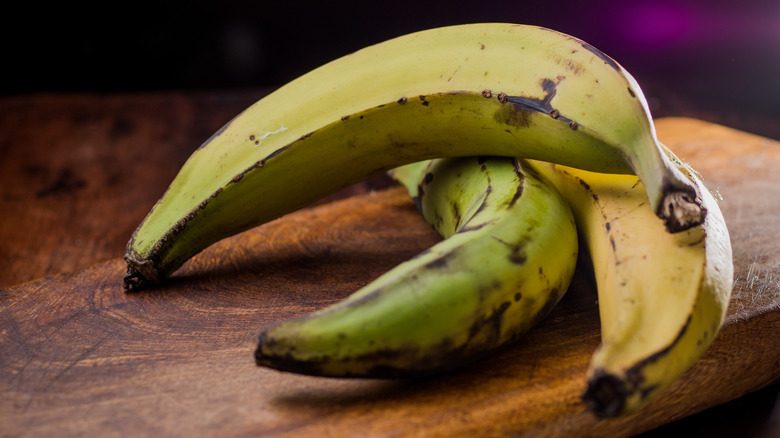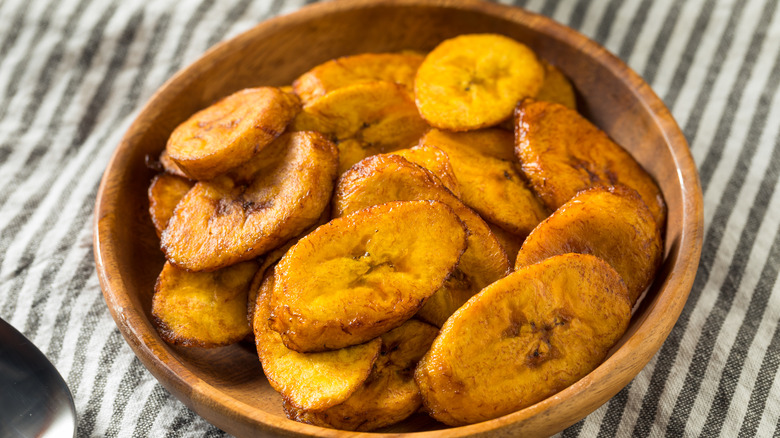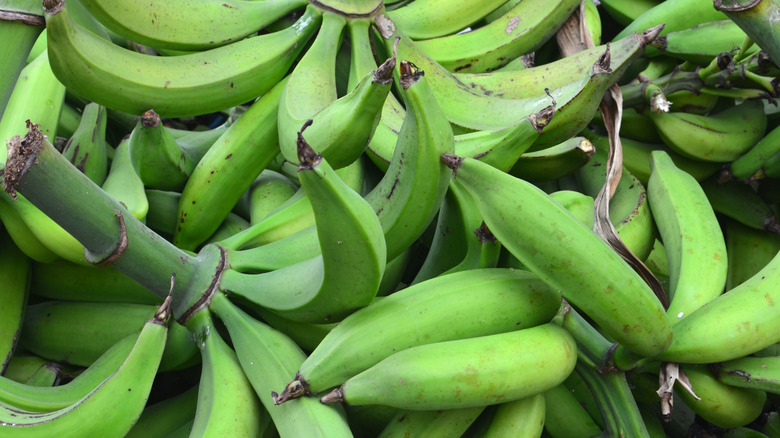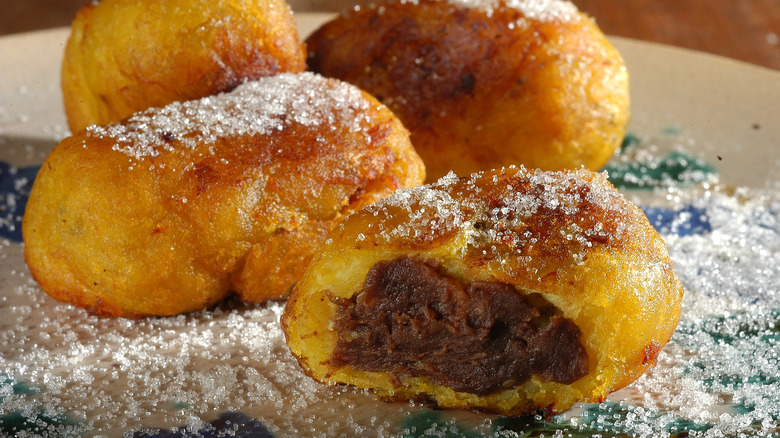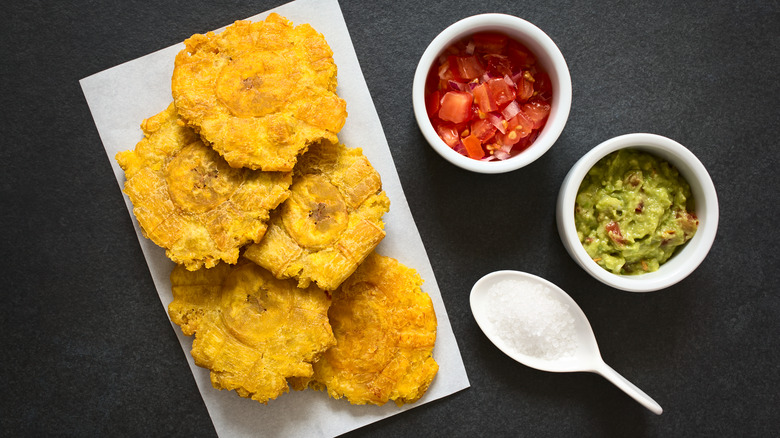What Are Green Plantains And Can You Eat Them?
Have you ever come back from a grocery run with a seemingly unripe bunch of bananas only to be baffled by how firm they are to touch? On closer inspection, you may even realize that they taste nothing like bananas at all. You haven't gotten a weird batch of bananas by random bad luck — what you have are actually green plantains. According to Consumer Reports, the import of this product in the U.S. increased by 41% between 2013 and 2018, so it's entirely possible that what you thought were jumbo-sized bananas in the fruit and vegetable aisle, are plantains in reality.
Although similar in appearance to bananas, these fruits are more like the tropical cousins of the former. The plant is usually grown in the Caribbean, Central America, and parts of Southeast Asia and has entered into a variety of cooking cultures (via The Pioneer Woman). Now that you have green plantains, you can take advantage of their unique flavor in a ton of different ways.
What are green plantains?
Plantains belong to Musaceae, also known as the family of banana plants (via Science Direct). As a result, these fruits look uncannily similar to bananas and are often mistaken for the latter.
Green plantains are starchy and more savory than sweet, per Bon Appétit. The green variety of this ingredient is considered to be unripe, but it is at this stage that they're considered to be ideal for cooking. While the item looks like fruit, they're usually cooked and eaten as vegetables. As unripe plantains ripen, the starches convert into sugar, making the produce become sweeter, though not as sweet as bananas, and the skin can go from green to yellow to fully black in color.
Green plantains have very thick skin and a sticky sap which makes it hard to peel the skin off. The Pioneer Woman recommends using a paring knife to separate the innards from its peel.
What do green plantains taste like?
Green plantains are almost always cooked because when eaten raw, they are starchy and flavorless. Livestrong compares its uncooked flavor to that of raw potatoes, adding that fresh versions of the ingredient are even more bitter.
When you prepare this fruit, it's an entirely different story. Due to their inherently neutral flavor, the ingredient can adapt easily to pretty much any dish that you add them to, much like potatoes (via The Pioneer Woman). Similar to potatoes, green plantains are usually deep-fried, seasoned, and eaten as chips or served as an accompaniment to main dishes.
Although the texture and taste make uncooked green plantains unappetizing, there's no harm in eating them raw (but you wouldn't really want to). Plantains are recognized as safe to be eaten by the Food and Agriculture Organisation, as they are relatively toxin-free. You can pick up this item at most major grocery stores, or at produce stands or farmers markets across the U.S. When in doubt, you can always order this ingredient from Walmart.
What's the difference between green plantains and bananas?
Although both bananas and plantains belong to the same family of fruits, the similarities start and end at their appearance. Healthline suggests that if you look closely, there are plenty of differences between the two. Green plantains are usually longer and larger in size than bananas and are firmer to touch. You also can't peel green plantains as easily as you can bananas and green plantains are higher in starch but lower in sugar than the latter.
The biggest difference between the two comes from their taste and the way in which they are cooked. While bananas are a great snack on the go, plantains, in general, do not taste good when eaten raw. Whilst bananas are sweet and make for great desserts and breakfast toppings, green plantains are almost always cooked, used in savory dishes, and are often eaten as fried chips.
For the most part, green plantains and bananas have a similar nutritional profile, but if green plantains are cooked, the preparation process can make this ingredient more or less nutritious.
How to cook with green plantains
Just like potatoes, green plantains are incredibly versatile. The trickiest bit when it comes to cooking with this ingredient is not the actual cooking bit, it's the prep. The Pioneer Woman recommends using a paring knife to chop off the top and the top and the bottom of the fruit. You should make four vertical cuts into the skin, making sure not to cut the flesh. Then, slide the knife between the skin and the flesh, gently prying off the peel.
Once the hard bit is done, you can go ahead and get creative. Green plantains can be boiled, baked, grilled, and steamed, however, frying is the more commonly preferred method of cooking. Bon Appétit recommends making tostones, a twice-fried snack of smashed green plantains tossed in seasonings, a fried food popular in the Caribbean and Latin America. Another easy way to use the ingredient is by swapping the unripe fruit in place of potatoes and using them to make chips. You can make fritters with the item or use chunky bits of the fruit as a soup-thickener, thanks to the starch found in the ingredient.
Healthline also notes that green plantains are an excellent starchy addition to gluten-free and paleo diets.
Are green plantains nutritious?
Green plantains are packed with nutrients, so much so that Healthline calls them a superfood. One cup of this fruit, when boiled, contains 166 calories, 1.5 grams of protein, 40 grams of carbohydrates, and 3.5 grams of fiber, per Very Well Fit.
Plantains are a great source of complex carbohydrates that derive from fiber and starch. These complex carbs can help you stay full for a longer period of time which helps curb hunger pangs. Plus, the fiber found in this ingredient makes the fruit good for helping with constipation.
One cup of the item contains 12.5 milligrams of vitamin C which makes up for a good chunk of your recommended daily vitamin C intake which may help give your immunity a boost and might protect against certain types of cancers. Plantains are high in potassium as well, which can help regulate blood pressure and improve heart health. Additionally, the fruit contains iron which makes them a great fruit to add to your diet if you need to get more of this essential mineral.
